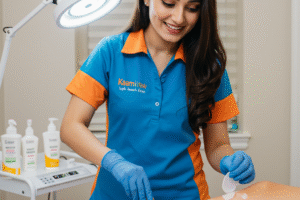Vitiligo, the chronic skin condition characterized by the progressive loss of skin pigment resulting in milky-white patches, affects individuals worldwide, including an estimated 0.5-2% of the Malaysian population. While not physically painful or contagious, vitiligo carries a profound psychosocial burden, often impacting self-esteem, social interactions, and quality of life due to its visible nature, particularly in a society where appearance can hold significant cultural weight. In Malaysia’s diverse landscape, navigating vitiligo treatment involves understanding the available medical options, managing expectations, accessing specialized care, and finding crucial emotional support. This article explores the current state of vitiligo treatment in Malaysia, offering insight and hope to those affected.

Understanding Vitiligo: More Than Skin Deep
Vitiligo occurs when melanocytes – the cells responsible for producing skin pigment (melanin) – are destroyed. The exact cause remains complex and likely involves an interplay of:
-
Autoimmunity: The body’s immune system mistakenly attacks its own melanocytes.
-
Genetic Predisposition: Family history increases risk.
-
Neurogenic Factors: Nerve chemicals potentially affecting melanocytes.
-
Oxidative Stress: Accumulation of damaging free radicals.
-
Environmental Triggers: Stress, skin trauma (Koebner phenomenon), or chemical exposure may play a role.
Vitiligo manifests in different patterns (focal, segmental, generalized/acral, universal) and progresses unpredictably. The emotional impact can be severe, leading to anxiety, depression, and social withdrawal, especially given cultural sensitivities around skin appearance in Malaysia.
The Treatment Landscape in Malaysia: Options and Accessibility
There is no single “cure” for vitiligo, but numerous treatment modalities aim to stop progression, induce repigmentation (return of colour), or achieve cosmetic camouflage. Treatment choice depends on the type, extent, location, and activity of vitiligo, the patient’s age, skin type, and personal preferences. Availability spans both public and private healthcare sectors:
-
Medical Therapies:
-
Topical Treatments: First-line options widely available.
-
Potent Topical Corticosteroids: Used cautiously for limited periods on small areas to reduce inflammation and potentially stimulate repigmentation (especially on face/neck). Risks include skin thinning.
-
Topical Calcineurin Inhibitors (TCIs – Tacrolimus, Pimecrolimus): Effective, particularly for facial/neck vitiligo and sensitive areas. Safer for longer-term use than steroids. Available privately and increasingly in public hospitals.
-
Topical Janus Kinase (JAK) Inhibitors (e.g., Ruxolitinib cream): A newer, promising class of drugs targeting the immune pathway. Approved in several countries (including some ASEAN nations) and accessible in leading Malaysian private dermatology centres, though the cost can be high.
-
-
Phototherapy: A cornerstone of vitiligo treatment.
-
Narrowband Ultraviolet B (NB-UVB): The gold standard phototherapy. Administered 2-3 times weekly in specialized dermatology departments (major government hospitals and private clinics). Effective for widespread vitiligo. Requires significant time commitment (months).
-
Excimer Laser/Excimer Light (308nm): Targets specific patches with higher intensity UVB. Faster results than NB-UVB for localized areas. Available in advanced private dermatology centres and some university hospitals. More expensive per session.
-
-
Systemic Therapies: For rapidly progressive or extensive vitiligo.
-
Oral Mini-Pulse Corticosteroids: Short bursts of low-dose steroids to halt progression. Prescribed cautiously by dermatologists.
-
Oral JAK Inhibitors (e.g., Tofacitinib, Ritlecitinib): Emerging systemic option showing significant repigmentation potential in trials. Not yet universally approved for vitiligo in Malaysia, but accessible off-label in specialized private settings for eligible patients under strict supervision. Requires thorough monitoring.
-
-
-
Surgical Therapies (For Stable Vitiligo):
-
Autologous Skin Grafting: Transferring small pieces of pigmented skin to depigmented areas. Available in specialized centres (public and private).
-
Suction Blister Epidermal Grafting: Lifting the top layer of pigmented skin and grafting it onto prepared depigmented areas.
-
Non-Cultured Epidermal Cell Suspension (NCES) / ReCell®: Harvesting melanocytes from a small pigmented skin sample, processing them into a suspension, and applying them to the depigmented area. This advanced technique offers repigmentation for larger areas with minimal donor site issues. Available in select leading private dermatology and plastic surgery centres in Malaysia (e.g., in Kuala Lumpur, Penang).
-
Tattooing (Micropigmentation): Implanting pigment into depigmented skin. Best for stable vitiligo in areas with darker skin tones or lips. Requires a highly skilled practitioner.
-
-
Depigmentation Therapy:
-
For extensive vitiligo (e.g., >80% body surface area) where repigmentation isn’t feasible or desired. Monobenzyl ether of hydroquinone cream permanently lightens remaining pigmented skin to achieve an even tone. Requires lifelong sun protection. Available under a dermatologist’s supervision.
-
-
Cosmetic Camouflage:
-
Highly effective waterproof concealers and make-up (e.g., Dermablend, Covermark) are available in pharmacies and beauty stores. Dermatologists can guide patients.
-
Accessing Care in Malaysia:
-
Public Healthcare (Hospitals & Klinik Kesihatan): Dermatology services are available in major government hospitals (e.g., Hospital Kuala Lumpur, Hospital Sultanah Bahiyah, Hospital Pulau Pinang). Access often requires referral. Costs are heavily subsidized. NB-UVB phototherapy and basic topical treatments are accessible, but waiting times can be long, and newer therapies (like JAK inhibitors or ReCell) are generally unavailable.
-
Private Healthcare: Offers wider access to advanced treatments (TCIs, JAK inhibitors, Excimer laser/light, surgical options like ReCell), shorter waiting times, and more personalized care. Costs are significantly higher. Many experienced dermatologists specializing in pigmentary disorders practice in major cities.
-
Insurance: Coverage for vitiligo treatments (especially newer, expensive ones) varies greatly. Patients should check their specific policies.
The Crucial Role of Support and Realistic Expectations:
-
Psychosocial Support: Vitiligo management MUST address the emotional impact. Counselling, support groups (like Vitiligo Support Malaysia), and connecting with others facing similar challenges are invaluable. Resources are growing but still limited.
-
Managing Expectations: Repigmentation is a slow process (often 6 months to 2 years), results vary significantly, and maintenance therapy may be needed. Complete reversal isn’t always possible. Treatment focuses on control and improvement.
-
Sun Protection: Paramount for all vitiligo patients. Depigmented skin burns easily and lacks natural UV protection. High-SPF broad-spectrum sunscreen and protective clothing are non-negotiable.
-
Avoiding Triggers: Minimizing skin trauma and managing stress can be beneficial.
The Future and Hope:
Research into vitiligo is accelerating. Newer JAK inhibitors (both topical and oral) show immense promise. Advances in cellular therapies and a deeper understanding of the immune mechanisms offer hope for more effective and targeted treatments shortly. Access to these innovations is gradually reaching Malaysia.
Conclusion:
Living with vitiligo in Malaysia presents unique challenges, but effective management is possible. A combination of medical therapies (from basic topicals to advanced biologics and surgery), accessible through both public and private sectors, offers pathways to control the condition and improve skin appearance. Crucially, integrating psychosocial support, practicing diligent sun protection, and setting realistic expectations are fundamental to holistic care. With growing awareness, advancing treatments, and strengthening support networks, individuals with vitiligo in Malaysia can move beyond the patches towards greater confidence and well-being.
5 FAQs on Vitiligo Treatment in Malaysia
-
Q: What is the most effective treatment for vitiligo available in Malaysia?
A: There’s no single “most effective” treatment for everyone. Effectiveness depends on the type, location, and extent of your vitiligo, your skin type, and how long you’ve had it. Narrowband UVB phototherapy is widely considered the gold standard first-line treatment for widespread vitiligo and is available in major government hospitals and private clinics. For smaller, stable patches, topical treatments like calcineurin inhibitors (Protopic, Elidel) or newer JAK inhibitor creams (Opzelura – available privately) can be very effective, especially on the face. Surgical options like ReCell show excellent results for stable, segmental vitiligo. A dermatologist will recommend the best approach for you. -
Q: Can vitiligo be completely cured? Will the colour come back permanently?
A: Currently, there is no guaranteed permanent “cure” that works for everyone. The primary goals of treatment are to stop the spread of depigmentation and stimulate repigmentation in the white patches. Repigmentation success varies: Some people achieve excellent, near-complete repigmentation, especially with early and consistent treatment on areas like the face. Other areas (hands, feet, lips) are more resistant. Colour can sometimes fade again over time, requiring maintenance therapy. Stability is key: Repigmentation treatments work best when the vitiligo is stable (not actively spreading). Even with successful repigmentation, lifelong sun protection is essential. -
Q: Does insurance cover vitiligo treatments in Malaysia? How much do they cost?
A: Coverage varies significantly depending on your insurance plan:-
Public Sector: Treatment in government hospitals (consultations, basic topicals, NB-UVB) is heavily subsidized, making it very affordable (<RM50 per session for UVB).
-
Private Sector: Costs are higher. Consultations (RM100-300+), topical medications (RM100-500+/tube), NB-UVB (RM50-150+/session), Excimer laser (RM200-500+/session). Advanced treatments are costly: JAK inhibitor creams (Opzelura) can cost RM800-1500+/tube. ReCell surgery typically ranges from RM8,000 to RM20,000+, depending on area size. Insurance: Many standard plans exclude vitiligo as a “cosmetic” condition. Some comprehensive plans may cover parts of treatment, especially if deemed medically necessary due to psychological impact. Crucially, check your specific policy details and discuss pre-authorization with your insurer and dermatologist.
-
-
Q: I’ve heard about traditional/herbal remedies (e.g., specific plants, oils) for vitiligo. Are they safe and effective?
A: Exercise extreme caution. While traditional medicine exists, there is little robust scientific evidence proving the safety and consistent effectiveness of most herbal remedies for vitiligo repigmentation. Risks include:-
Skin Irritation/Allergy: Can worsen vitiligo via the Koebner phenomenon (new patches appearing on injured skin).
-
Ineffectiveness & Delayed Care: Relying solely on unproven remedies delays access to evidence-based treatments that could stop progression early.
-
Unknown Interactions: Potential interactions with prescribed medications.
-
Contamination/Purity Issues. Always consult your dermatologist before trying any alternative remedy. They can advise on safety and evidence. Sun protection remains the only universally recommended non-prescription strategy.
-
-
Q: Can I get pregnant while undergoing vitiligo treatment? What treatments are safe?
A: This requires direct consultation with your dermatologist and obstetrician. Many vitiligo treatments carry potential risks during pregnancy and breastfeeding:-
Topical Corticosteroids: Potent steroids should be used minimally and cautiously on small areas; there is an absorption risk.
-
Topical Calcineurin Inhibitors (TCIs): Systemic absorption is low, but safety data in pregnancy is limited. Often avoided as a precaution.
-
Topical JAK Inhibitors: Generally contraindicated during pregnancy and breastfeeding due to limited safety data.
-
Phototherapy (NB-UVB): Generally considered the safest option during pregnancy and breastfeeding, as UV light doesn’t penetrate deeply. Shielding the abdomen/belly is still recommended.
-
Systemic Medications (Steroids, JAK inhibitors): Generally contraindicated or used only in extreme circumstances under strict supervision. Planning is key: Discuss family planning with your dermatologist well in advance to adjust or pause treatments safely. Sun protection remains safe and essential.
-



